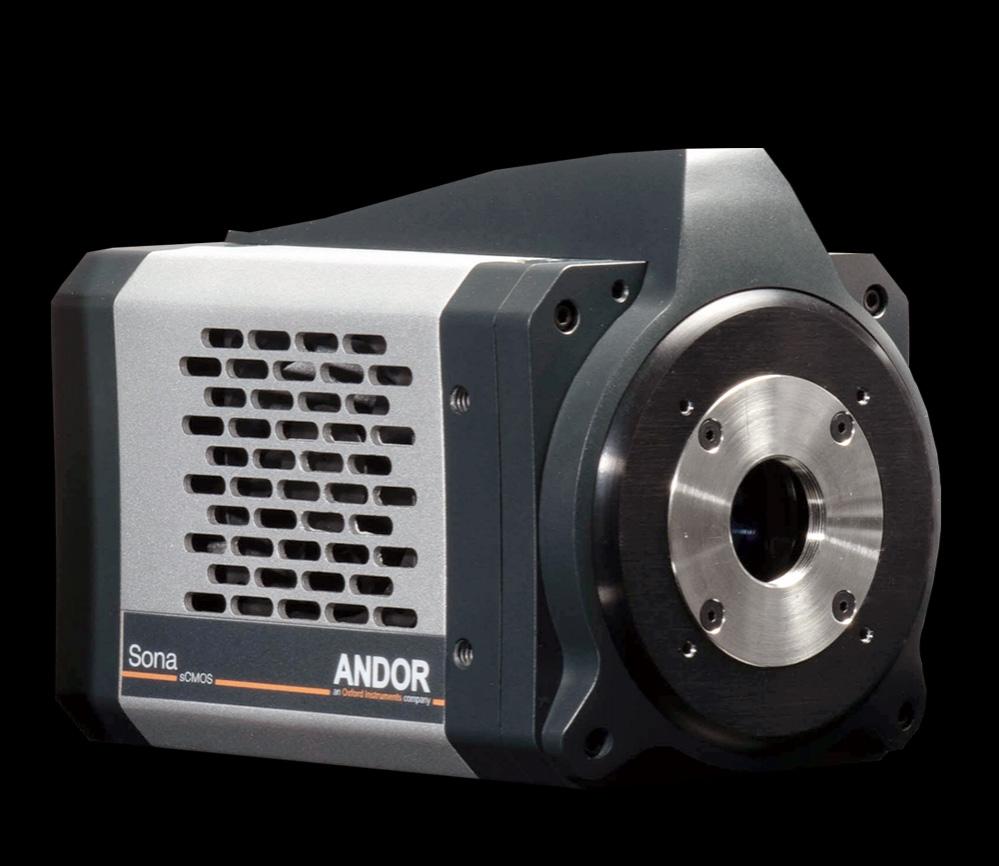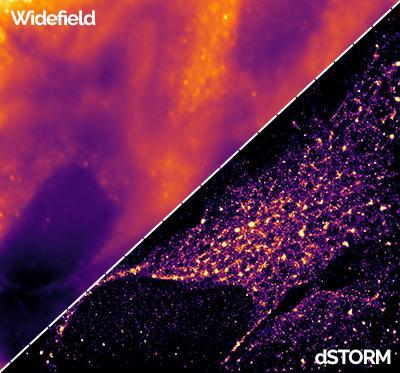Resources
 Part of the Oxford Instruments Group
Part of the Oxford Instruments Group
Expand
Collapse
Single Molecule Detection is an important technique, providing additional insights into cellular machinery hidden from more conventional “bulk” imaging methods. It is also used as a basis for super-resolution for enhanced resolution of intracellular components and studying protein and membrane interactions and kinetics, as well as single molecule FISH.
For many years, Andor’s iXon EMCCDs have been the gold standard in detection for the biophysics laboratory. Refined and perfected, the latest iXon EMCCDs continue to be proven as the most sensitive detector technology for when the most critical measurements are required.
Single molecule studies are widely used in many areas of science to gain an understanding of individual biomolecules that is not possible in conventional ensemble imaging experiments:
| TIRF Microscopy | FRET | Localization-based Super Resolution | Fluorescence Correlation Spectroscopy (FCS) | |
| Typical Applications | ✅ Live analysis of protein-membrane interactions ✅ Membrane trafficking dynamics ✅ Vesicles and endosomes ✅ Endo and Exocytosis ✅ Single protein trafficking |
✅ Protein to protein interactions ✅ Co-localisation studies ✅ Protein structure analysis ✅ Protein dynamics |
✅ Resolve intracellular structures ✅ Spatial organization of molecules in tissues ✅ Single molecule FISH ✅ Multiplexed in situ imaging ✅ Transcriptomics |
✅ Determine diffusion rates ✅ Study binding and disassociation rates ✅ Detect protein conformation changes ✅ Concentrations measurements in cytoplasm and cell compartments |
| Summary of Technique | Total Internal Reflectance Fluorescence (TIRF) Microscopy exploits the optical properties of an evanescent wave to provide high resolution to a restricted depth. Suited to studies of the many important and dynamic processes at the cell membrane boundary. Find out more about TIRF. |
Förster Resonance Energy Transfer (FRET) enables the proximity of two fluorophores to be determined with precision. It is therefore used to infer distance and interaction relationships between FRET labelled biomolecules. Find out more about FRET. |
Localisation of fluorophore emission is the basis for many super-resolution methods such as STORM, PALM and DNA Paint. Such techniques are used to resolve intracellular structures below the classical limit of resolution and provide spatial information of labelled biomolecules within tissues. Find out more about transcriptomics or super resolution. |
Fluorescence Correlation Spectroscopy (FCS) is different to the other techniques in that it is a fluorescence spectroscopy-based technique that provides temporal information at the single molecule level. Fluctuations in fluorescence can be used to determine information on reaction and diffusion rates. Find out more about FCS. |

Single molecule imaging experiments involve inherently weak signals and thus demand the most sensitive detectors available. iXon EMCCD cameras have a proven history as the detectors of choice for the most challenging single molecule and biophysics experiments. Andor’s latest iXon Ultra and Life models are the most sensitive cameras available, bar none.

The latest back-illuminated sCMOS technology narrows the gap towards EMCCD. Andor’s new Sona back-illuminated sCMOS series fully exploits the sensor technology. Suitable for experiments with higher signal regimes. Sona sCMOS cameras may provide benefits of exceptional speeds over the widest possible fields of view and wide dynamic range.
EMCCD and back-illuminated sCMOS cameras are broadly suitable for the main techniques used for single molecule detection – e.g. confocal, TIRF, FRET or single molecule localization based super resolution. The technologies each have their own benefits – so which one will suit best? The following guide provides a comparison of the different camera models against various experimental requirements
| Back-illuminated EMCCD cameras | Back-illuminated sCMOS cameras | |||
| Application Requirement | iXon Life/ Ultra 888 | iXon Life/ Ultra 897 | Sona 4.2B-6 | Sona 4.2B-11 |
| Capture weakest signals |
|
|
|
|
| High Sensor Resolution1 |
|
|
|
|
| Image a Wide Field of View |
|
|
|
|
| High speed Imaging2 |
|
|
|
|
| High Dynamic Range |
|
|
|
|
| Long exposure suitability3 |
|
|
|
|
| High quantitative accuracy |
|
|
|
|
| Summary | When ultimate sensitivity is required over the largest field of view. | When ultimate sensitivity is required and wide field of view is not a priority. | Highly flexible imaging solution provides wide field of view and highest speeds for higher signal levels. | For a balance of high sensitivity and field of view at higher signal levels. |
1 Effective image resolution for light microscopy is set by the microscope objective (Resolution=λ/2NA) and the technique used. Smaller pixel sizes will meet, or exceed Nyquist sampling at lower objective magnifications and may help with localization based experiments, super resolution or deconvolution.
2 EMCCD cameras may run at higher frame rates by cropping the sensor to a smaller field of view. Although faster on paper high speeds on sCMOS only possible if signal levels are suitable during each exposure period.
3 sCMOS cameras are most suitable for short exposures. EMCCD cameras can be used for extended exposures into minutes due to exceptionally low dark current. Ultra models benefit also from having conventional CCD mode.
Still not sure which camera to choose, contact our application specialists.

The Dragonfly is a multimodal confocal system. It naturally benefits from Andor EMCCD and sCMOS technologies, with motorized optical zoom, the system delivers industry-leading signal to noise and image fidelity. Applications ranging from single molecule to live cell confocal, TIRFM to whole embryo and thick tissue imaging all benefit from the system’s speed and sensitivity. Dragonfly delivers real-time visualization for rapid specimen evaluation and ClearView-GPU™ deconvolution to maximize resolution and throughput.
Please take a look below at some of the single molecule imaging webinars and technical articles available in the learning center.